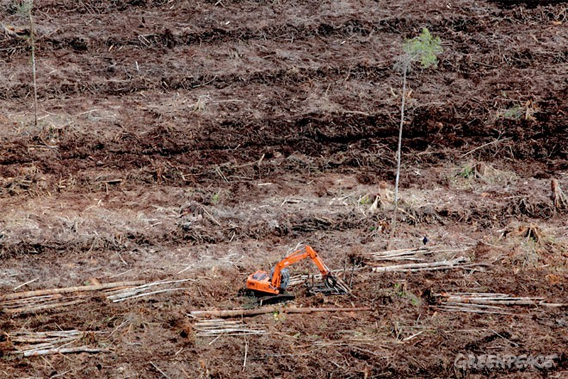Ministry of Forestry signed off on clearing of forest with protected species in Indonesia
Indonesia's Ministry of Forestry signed off on a plan by Asia Pulp & Paper (APP) suppliers to log areas of forest that contained protected ramin species, according to documents released by Greenomics-Indonesia, an activist group
mongabay.com | March 15, 2012
 Active clearance of peat swamp forest by APP pulpwood supplier PT Mutiara Sabuk Khatulistiwa. Photo © Greenpeace.
Active clearance of peat swamp forest by APP pulpwood supplier PT Mutiara Sabuk Khatulistiwa. Photo © Greenpeace.
The micro-delineation documents, which are required to win approval for forestry projects in Indonesia, confirm that APP suppliers were aware that ramin trees were present in the concessions, which have since been converted to wood-pulp plantations.
The revelations come shortly after Greenpeace released the results of an investigation that found contraband ramin logs at APP's Indah Kiat Perawang pulp mill. The findings potentially put APP in violation of Indonesian law and CITES, an international agreement on trafficking of endangered species. They could also theoretically result in sanctions against some APP products in the United States under the Lacey Act.
For its part, APP said it would investigate Greenpeace's findings. Last week it sent a "specialist team" to the mill, although it is unclear whether any independent auditors were present during the exercise.
Is Indonesia's Ministry of Forestry ignoring the country's commitment under the Convention on International Trade in Endangered Species of Wild Fauna and Flora (CITES)?
The paper products giant maintains it has a "a strict zero tolerance policy for illegal wood entering the supply chain and has comprehensive chain of custody (CoC) systems to ensure that only legal wood enters its pulp mill operations." APP says it surveys forest areas for ramin trees prior to clearing. Any protected species are left standing, though observers say these usually fair poorly without other trees to protect them from wind damage.
APP also says its system includes checks to "automatically reject or destroy unqualified wood, including protected species, in line with the respected law and regulations."
"Unqualified wood, including Ramin and other protected species, is clearly identified, separated, filed and reported," it says. "A warning and penalty are given to the wood supplier."
Still APP has yet to explain why Greenpeace was able to document ramin logs among other logs in its facility in Sumatra. Furthermore, independent testing has found mixed tropical hardwood (MTH) — which in Asia only come from rainforests — in some of APP's virgin fiber products, indicating that rainforest trees — whether or not they are ramin — are indeed being used as a source of fiber.
The new Greenomics report raises broader questions about the Ministry of Forestry's approval process for concessions in areas with protected species. APP suppliers appear to have clearly disclosed the presence of ramin in their micro-delineation documents, yet they didn't request — nor did the Forestry Ministry demand — the required permit for logging ramin habitat.
In the end, it is unclear whether ramin trees — even if spared from initial clearing — survived the conversion of their habitat to pulpwood plantations. It may be that ramin are incapable of thriving after their ecosystem is lost.










1 comment:
Great information! I love your blog! You always post interesting things!
Post a Comment